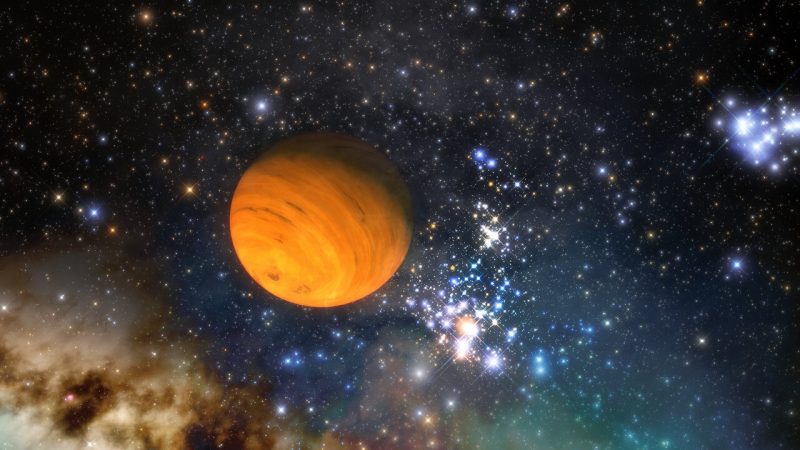Astronomers announced on December 22, 2021, that they’ve found somewhere between 70 and 170 rogue, or free-floating, planets; that is, planets not currently in orbit around a star. This mass of unattached planets, each approximately the size of Jupiter, lies in a region of the Milky Way known as the Upper Scorpius OB stellar association. These newly found free-floating planets nearly double the total number of rogue planets already known.
The peer-reviewed journal Nature Astronomy published the rogue planet discovery on December 22, 2021.
Location of the rogue planets
The team of astronomers used observations and archival data from telescopes around the world and in space to make their discoveries. They sifted through 80,000 wide-field images taken over 20 years. Núria Miret-Roig and Hervé Bouy at the University of Bordeaux in France took a census of all the stars, brown dwarfs and rogue planets greater than four Jupiter masses in the Upper Scorpius region.
This region of sky, the Upper Scorpius OB association, lies 420 light-years away from Earth. Amateur astronomers might be familiar with this region of sky because it contains favorite targets for astrophotographers, including the colorful region around Rho Ophiuchi plus dark nebulae such as the Pipe Nebula, Barnard 68 and the Coalsack.

A new rogue planet detection method
Previously, astronomers discovered free-floating planets with microlensing surveys. With this method, astronomers witness a brief chance alignment between a rogue planet and a background star. The drawback is that the scientists can’t make follow-up observations with these one-time microlensing events.
In the new study, scientists looked for rogue planets that were still young, within a few million years of their formation. Normally, a planet that is not near its parent star wouldn’t be visible to astronomers without a source to illuminate it. But these young planets are still hot enough to glow. So Miret-Roig and her team looked for direct images of them with sensitive cameras on large telescopes. They measured the points of light in optical and near-infrared wavelengths in the Upper Scorpius region and combined the measurements with the movement they detected. Miret-Roig said:
We measured the tiny motions, the colors and luminosities of tens of millions of sources in a large area of the sky. These measurements allowed us to securely identify the faintest objects in this region.
The origin of the rogue planets
The scientists also wonder how these rogue planets came to be. Were they ejected from a solar system like our own? Or did they form from the collapse of a gas cloud that was too small to create a star? (Which also brings up the as-yet-unanswered question, if the rogue planet doesn’t orbit a star or didn’t originally form around a star, is it still, by definition, a planet?)
If the origin of rogue planets was due to ejection from a stellar system, it suggests there could be an abundance of Earth-sized free-floating planets out there. As Miret-Roig explained:
The free-floating Jupiter-mass planets are the most difficult to eject, meaning that there might even be more free-floating Earth-mass planets wandering the galaxy.

An inexact number of free-floating planets
Sean Raymond, also of the University of Bordeaux and one of the authors on the paper, explained on Twitter why the number of planets is in a range between 70 and 170:
A younger age for the star-forming region (and therefore the rogue planets)
=> objects are less massive for a given brightness
=> more free-floating *planets* (rather than brown dwarfs, with M>13 MJup).
— Sean Raymond (@sraymond_astro) December 22, 2021
This star-forming region of space – the Upper Scorpius region – is from 3 to 10 million years old. If the star-forming region is younger and closer to the 3 million year age, then the objects the scientists singled out are more likely young, hot planets. If the star-forming region is older, then the candidates are also older, and their brightness comes from a larger size, not youth. In this case, some of them may therefore be brown dwarfs (failed stars).

Could rogue planets have life?
What are these rogue planets like, and would they be suitable for life? Well, for one, they might have moons. As Raymond said on Twitter:
Some ejected gas giants hold onto their moons! We can speculate that tidal heating might maintain not-too-frigid temperatures in the interiors of such moons.
Which, of course, sounds rather conducive to the existence of life. What about Earth-like planets and water, aka, life as we know it? Raymond also tweeted:
Can liquid water or life exist on free-floating planets? We don’t know, of course, but models find that liquid water can persist under a layer of ice or a thick atmosphere of molecular hydrogen.
We can imagine what such life *might* look like: https://t.co/DkCe3rENMT
12/
— Sean Raymond (@sraymond_astro) December 22, 2021
The scientists hope to answer some of their many questions in the years to come. With the new Vera C. Rubin Observatory coming online, they’ll likely find many more free-floating planets.
Bottom line: Astronomers have nearly doubled the number of known rogue planets with a recent discovery using archive images from the Upper Scorpius region.
Source: A rich population of free-floating planets in the Upper Scorpius young stellar association











